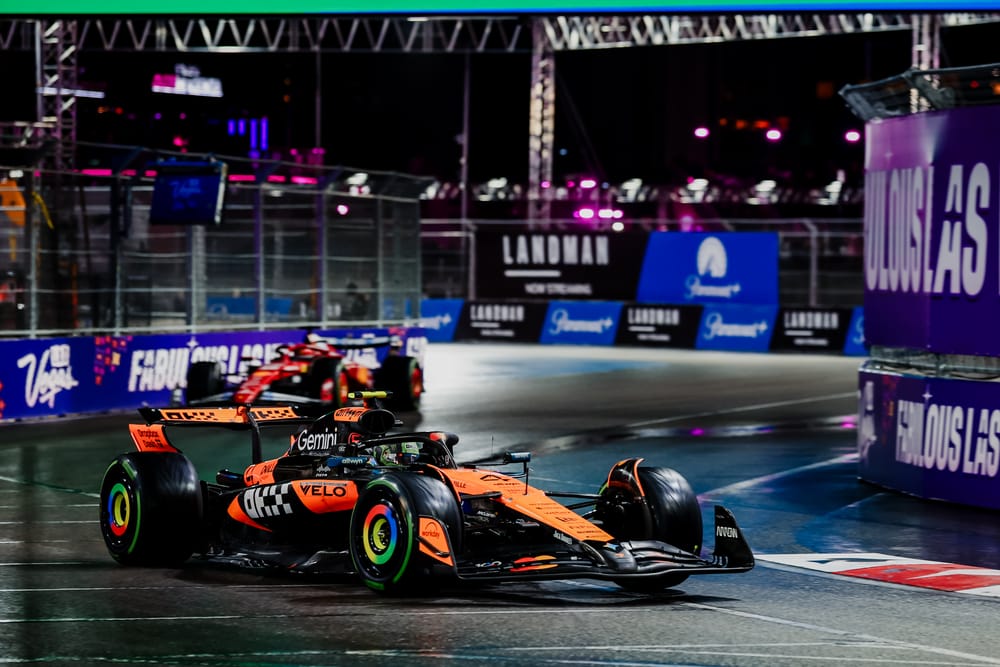In terms of degree of difficulty, this was probably the trickiest Formula 1 qualifying session of the entire year so far.
It had a transition from wets to inters on a super low-downforce and gripless track after precious little relevant practice running. Super-fast corners that were mere kinks in the dry but a 180mph risky handful now. Poor visibility, slippery painted road markings and solid walls just waiting to rush up at you.
Then there was trying to pick out braking points in the middle of receiving vital radio instructions about track positioning and battery recharge modes on a quickening track.
That there were no red flags and only one driver (Alex Albon in Q1) hitting the wall was remarkable and a brilliant testimony to the immense physical skill and mental acuity of all the drivers.
Through the gloom with perfect timing came Lando Norris, putting his McLaren on pole from Max Verstappen by a handy 0.323s, the Red Bull only just clear of an over-delivering Carlos Sainz in the Williams.
Norris’s was a brilliant combined performance from in the cockpit and on the pitwall. Running on the same tyres throughout the session, the operational challenge when every lap throughout Q1, Q2, and Q3 happened on a track faster than on the previous lap, sometimes by a lot, was in trying to be one of the last to begin the final lap so as to catch the track at its quickest while also ensuring adequate battery charge.
You could approach the battery challenge the safe way – by running it in balanced mode, so keeping as much energy coming in as was being expended and just doing continuous attack laps, as Red Bull and Max Verstappen initially chose to do.
Or you could be bold, like McLaren and George Russell, specify harvesting laps to punctuate full-deployment attack laps.
The downside risk of that was you’d be on a charge lap just before the rain returned and so you’d waste the track at its quickest. But the rain – which had been falling hard enough at the beginning of Q1 to require full wets in that session – held off in Q3.
Being second car out in Q3 (behind Charles Leclerc’s Ferrari) gave Norris the opportunity of fitting in six laps (four attack and two charging). It meant he was relatively early across the line for the final time but it got him the extra lap, allowing him to further refine and trim 0.3s off his previous best (despite a big wayward moment through Turn 14 that lost him around 0.7s and which he was sure was going to cost him pole).
Everyone else got in only five.
Team mate Oscar Piastri crossed the line to begin his fifth and final lap at the perfect time, just before the clock counted down to zero, but the preparation for that lap had been compromised by the need to stay ahead of Isack Hadjar’s Racing Bulls on the previous lap, requiring Piastri to turn off his recharge mode.
This in turn meant doing the first few corners without full deployment in compensation and then having to switch to full deployment after Turn 4. This messy start lost Piastri almost 0.4s to Norris in the first sector.
As it happened it didn’t matter, because yellow flags at Turn 12 for Charles Leclerc going up the escape road ruined Piastri’s lap anyway and left him relying on his previous lap when the track was slower. All of which left him only P5 when P2 looked possible on merit and maybe even pole thanks to Norris’ Turn 14 moment.
But Piastri’s underlying pace was never quite up with that of Norris. Piastri was taking longer to get tyre temperature and confidence in the braking zones.
Verstappen reckoned the Red Bull was more competitive on the full wets than on the inters. “The lap felt alright,” he reported, “but it was not nice. It felt like driving on ice.”
Sainz had made some set up changes in anticipation of the rain, reckoning on grid position over dry track race pace. He’s not confident that he will hold onto P3 in the grand prix.
George Russell would doubtless agree. Fourth on the grid for the Mercedes was actually a disappointment after he’d been quickest in Q1 and Q2 (and FP3).
Running a little more downforce than the others, the Mercedes was still respectably quick on the straights and was generating its tyre temperatures effectively.
He would surely have been a pole contender but for a power steering problem in Q3.
“I didn’t hit anything but suddenly the steering was really heavy and stiff and almost locking in position sometimes,” he explained.
“When you’re trying to commit to high-speed corners it wasn’t great. I was even asking my engineer if it was safe to continue.”
Liam Lawson was revelling in the conditions, P6, two places ahead of team-mate Hadjar, the Racing Bulls sandwiching Fernando Alonso’s Aston Martin.
Leclerc’s over-commitment into Turn 12 on his final lap left him ninth, ahead of Pierre Gasly, quick (by Alpine ’25 standards) all weekend around a track he was superb at last year.
Lewis Hamilton went out in Q1, seemingly confusing the timing line (which he’d crossed just in time) with the start/finish line a little further up.
Believing he’d not made it in time he backed off. But even before that he’d been struggling to get the tyres up to temperature. In the dry, both Ferraris looked pole-contending quick, but it’s not a car which likes the wet, especially on such low wing settings.



